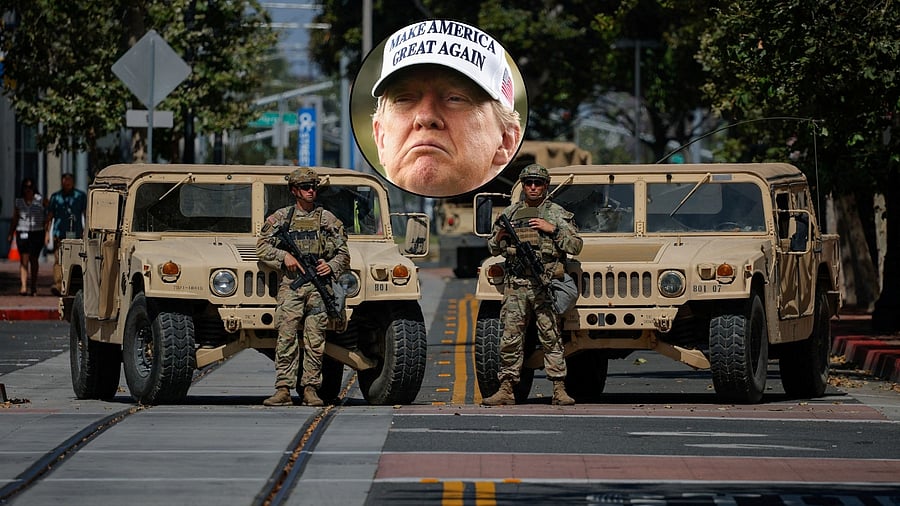
California National Guards deployed in Los Angeles. (Inset: US President Donald Trump).
Credit: Reuters Photos
The disturbances in Los Angeles are not just another routine clash between protestors and law enforcement, which occurs in the United States for multiple reasons from time-to-time. There are at least three sub-plots to the main drama being played out in the world’s creative capital and the second most populous city in the US.
The ongoing events in California are a mini rehearsal for the next US presidential election, in 2028. As the anti-Donald Trump protests spread to other cities, they are becoming dress rehearsals for the mid-term Congressional elections in 17 months. If Republicans lose both chambers of Congress next year, US President Donald Trump will be stopped in his tracks. In the greater likelihood of Democrats regaining control of only the House of Representatives, Trump will become a lame duck for the remainder of his term.
The second, but less-known sub-plot concerns the intrigues and machinations in the Trump family, which are not far from anything in US politics since the incumbent president successfully entered public life. California’s governor Gavin Newsom was once married to Kimberly Guilfoyle, who was until recently the fiancé of Donald Trump Jr., the president’s son by the late Ivana Trump.
Celebrity stateside media has been rife with reports since March that Guilfoyle, a successful television personality, is helping to rebrand Newsom to be the Democratic presidential nominee in 2028. Notably, the president has nominated Guilfoyle as the next US ambassador to Greece, which will send her far away from Newsom, across the Atlantic, to Europe.
The third sub-plot is that howsoever the Los Angeles protests end, immigration into the US is no more an issue that can be pushed under the carpet. It is a disease for which major surgery cannot be put off anymore. Band-Aid will not do. The US is set to transform into a society very different from the New World it has symbolised since the Pilgrim Fathers arrived there in 1620.
The tale of the two exes, the governor and the ambassador-designate, is the most luscious of the three sub-plots, but the serious character of this opinion space demands the other two have to be prioritised.
Thirty-eight states will go to the hustings between November and 12 months hence to elect governors. The events in Los Angeles and its nation-wide fallout have ensured that immigration actions by these states will determine which party retains control of these gubernatorial mansions. A landslide for either party will give the winning side a stranglehold over the US. Democrats are vulnerable because for too long, they have pandered to immigrant lobbies in their party and have been lax in tightening border controls.
Justin Trudeau’s experience in Canada is a lesson for Democrats south of the border: the former prime minister appeased Khalistanis and other terrorist supporters from several parts of the globe within his Liberal Party to a point where he was discredited, cutting short his political career at the relatively young age of 53.
Being an astute politician, Trump has begun turning his firepower away from what constituted his ‘enemies’ in the first five months as president — near-majority Democratic numbers in the Congress and a constant pain in his neck of a judiciary, which refuses to submit to Trump. His new targets are the governors of ‘blue’ Democratic states. California is the most obvious choice because it is deep blue, it sends the largest contingent to the electoral college that elects the US president, and it is a border state, which has not well-managed its checks on immigration.
But Trump runs enormous risks in doing this. California, taken as an independent entity, is the fourth largest economy globally. Its growth rate of 6% last year, was higher than that of every Group of Seven (G7) rich nation, including the US as a country.
The turbulence in Los Angeles is starting to damage this impressive growth story, which could have a cascading effect on the national economy. As the mid-term Congressional polls approach, Republicans are potentially more beleaguered than they already are. In this cat-and-mouse game of political economy, Newsom is trying to steal a march over Trump. Two months before the immigration crackdown in Los Angeles, the governor far sightedly challenged in court the president’s powers to enact tariffs which hurt states like California. A Washington Post-Ipsos poll earlier this month on Republican budget legislation may be a writing on the wall. Nearly double the number of Americans polled were against the bill compared to those who supported it.
Although presidential elections are more than three years away, all these are contributing to a spring in Newsom’s steps towards the White House. That is the state of play now as the events in Los Angeles continue to unfold.
(K P Nayar has extensively covered West Asia and reported from Washington as a foreign correspondent for 15 years.)
Disclaimer: The views expressed above are the author's own. They do not necessarily reflect the views of DH.